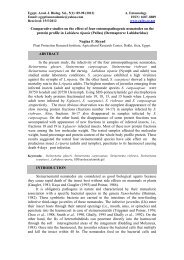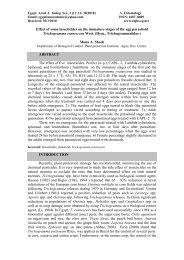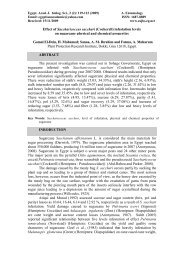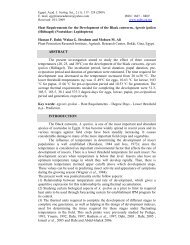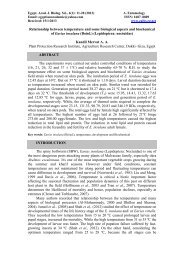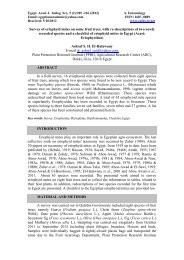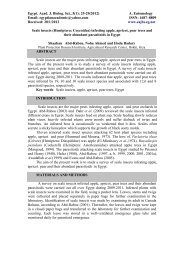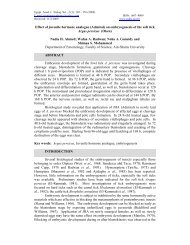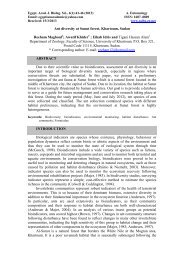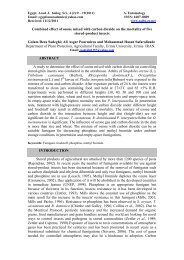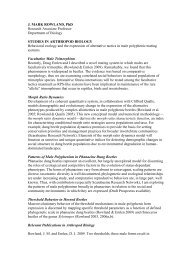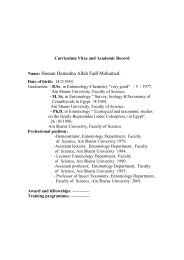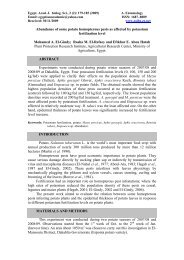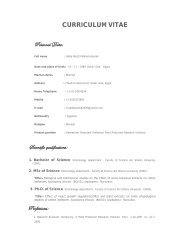Comparison of RAPD and PCR-RFLP markers for classification and ...
Comparison of RAPD and PCR-RFLP markers for classification and ...
Comparison of RAPD and PCR-RFLP markers for classification and ...
Create successful ePaper yourself
Turn your PDF publications into a flip-book with our unique Google optimized e-Paper software.
188<br />
Fatma H. Galal<br />
generates <strong>PCR</strong> products by annealing to r<strong>and</strong>omly distributed homologous target sites<br />
<strong>of</strong> the template DNA. This technique mostly generates dominant <strong>markers</strong>, although<br />
length polymorphisms caused by insertions/ deletions can also occur at low<br />
frequencies. Because <strong>of</strong> its relative simplicity, <strong>RAPD</strong> technology is being extensively<br />
used in genetic analysis <strong>of</strong> various plant <strong>and</strong> animal species. However, limitations in<br />
the applications <strong>of</strong> <strong>RAPD</strong>s such as the dominant nature <strong>of</strong> the <strong>markers</strong>, chance comigration<br />
<strong>of</strong> b<strong>and</strong>s at different loci, <strong>and</strong> requirement <strong>for</strong> stringent protocol<br />
st<strong>and</strong>ardization to ensure reproducibility have also been encountered (Black, 1993).<br />
As <strong>PCR</strong> technology finds increased use in genetic analysis, novel variations <strong>of</strong> this<br />
technique are emerging which promise precision, economy <strong>and</strong> speed (Wu et al.,<br />
1994; Zietkiecwicz et al., 1994; Vos et al., 1995).<br />
The aim <strong>of</strong> the present study was to evaluate <strong>RFLP</strong>s <strong>and</strong> <strong>RAPD</strong>-<strong>PCR</strong> assays as<br />
molecular marker systems <strong>for</strong> <strong>classification</strong> <strong>and</strong> taxonomic studies using<br />
representative <strong>for</strong>micid species <strong>of</strong> the order Hymenoptera. This evaluation was based<br />
on terms <strong>of</strong> cost, speed, amount <strong>of</strong> DNA needed, technical labor, degree <strong>of</strong><br />
polymorphism, precision <strong>of</strong> genetic distance estimates <strong>and</strong> the statistical power <strong>of</strong> the<br />
test.<br />
MATERIALS AND METHODS<br />
Insect material <strong>and</strong> DNA extraction<br />
Three species <strong>of</strong> adult ants, Camponotus maculatus, Monomorium pharoensis<br />
<strong>and</strong> Cataglyphis bicolor, were used in the present study. All DNA extractions were<br />
per<strong>for</strong>med using DNeasy tissue kit (QIAGEN, GmbH, Hilden, Germany) following<br />
the manufacturer’s instructions. Individuals from each insect species were pooled to<br />
reach ≈0.1-0.5 g tissue weight <strong>and</strong> homogenized in a sterile 2 ml microcentrifuge tube<br />
<strong>and</strong> incubated in lysis buffer overnight at 60 ◦ C. The lysate <strong>of</strong> the whole insect body<br />
was used to isolate total genomic DNA.<br />
<strong>RAPD</strong> analysis<br />
<strong>RAPD</strong> analyses were per<strong>for</strong>med using 40 primers obtained from Operon<br />
Technologies Inc., Alameda, Calif. (kits A <strong>and</strong> B). Reactions were per<strong>for</strong>med in 25 μl<br />
volumes containing 50 mM Tris, pH 8.5, 1 mM MgC12, 20 mM KC1, 500 mg/ ml<br />
BSA, 2.5 % Ficoll 400, 0.02 % Xylene cyanole, 1 unit Taq polymerase, 50 ng<br />
template DNA, 1 μM primer, <strong>and</strong> 0.2 mM dNTPs. A negative control, containing<br />
water instead <strong>of</strong> template, was included in each reaction set. The amplification<br />
program used was 5 min at 94°C (hot start), 1 min at 94°C, 2 min at 30°C <strong>and</strong> 2 min<br />
at 72°C <strong>for</strong> 40 cycles followed by one cycle <strong>of</strong> 72°C <strong>for</strong> 7 min. <strong>PCR</strong> amplification<br />
was carried out in a DNA thermal cycler (Model 380 A, Applied Biosystems, CA,<br />
USA). Following amplification, the reactions were visualized on 2 % agarose gel<br />
prepared in lx TAE buffer (Sambrook et al., 1989) containing 0.1 μg/ ml <strong>of</strong> ethidium<br />
bromide <strong>and</strong> photographed using gel documentation system.<br />
<strong>PCR</strong>-<strong>RFLP</strong> analysis<br />
The DNA was suspended in 100 µl <strong>of</strong> TE buffer (pH 8.0) <strong>and</strong> used <strong>for</strong> <strong>PCR</strong><br />
amplification <strong>of</strong> the ITS region. The universal primers ITSF <strong>and</strong> ITSR (Collins <strong>and</strong><br />
Paskewitz, 1996) were used <strong>for</strong> the amplification <strong>of</strong> ITS using the <strong>PCR</strong> cycling<br />
parameters as described by Pr<strong>of</strong>t et al. (1999). The <strong>PCR</strong> individual b<strong>and</strong>s <strong>of</strong> ITS<br />
region were visualized <strong>and</strong> eluted from the gel using GenClean Kit (Invitrogen<br />
Corporation, San Diego, CA, USA) as described by the manufacturer. The purified<br />
<strong>PCR</strong> products were subjected to single digestion with EcoRI, MspI, TaqI <strong>and</strong> SacI<br />
enzymes (Promega, Corp. Madison, WI, USA) overnight at 37 ◦C in a 20 μl reaction



